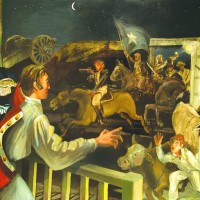
Remarkable Moments in Baton Rouge History
There are many remarkable moments in the history of Baton Rouge. Here are a few of my favorites:
The Red Stick or Istrouma
•In 1699, French noblemen and explorers Iberville and Bienville sighted a large cypress tree stained with animal blood on the banks of the Mississippi. It was called Istrouma and served as the boundary between the Houma and the Bayougoula Indians. They named the place Baton Rouge, or red stick.
The 14th British Colony
• In 1763, West Florida became the 14th British colony. The seat of government was Pensacola, but governmental affairs were also conducted at Biloxi and Baton Rouge. The people elected an Assembly, the first democratic body in which present day Louisiana was represented.
American Revolution
•In 1779, the people of Baton Rouge aided the Spanish in capturing British Fort Richmond and defeating 300 Hessian soldiers thereby ending British rule. West Florida became a Spanish colony.
Republic of West Florida
•In 1810, the people of Baton Rouge joined with others throughout the Spanish colony of West Florida to attack the Spanish fort in Baton Rouge and overthrow Spain. They established the Republic of West Florida and eventually became part of the United States.
First Steamboat to Visit
•The steamboat New Orleans plied the Mississippi River from New Orleans to Natchez beginning in 1811. It visited Baton Rouge on its first voyage.
Most Famous Visitor
•In 1826, the Marquis de Lafayette, a hero of the Revolution toured America on the 50th anniversary of 1776. One of his stops was Baton Rouge, where he addressed the people, reportedly from the balcony of the Tessier Building on what is now called Lafayette Street.
Baton Rouge Becomes Capital
•In 1846, the legislature voted to make Baton Rouge the State Capital. The cornerstone of the capitol building was laid on Nov. 2, 1847 by Gen. Philemon Thomas. Gen. Thomas, born in Virginia in 1763, was a boy soldier in the American Revolution, led West Florida forces which overthrew Spain in 1810, fought for the Americans at the Battle of New Orleans, and represented Louisiana for two terms in Congress. Shortly after laying the cornerstone of the capitol, he died on Nov. 18, 1847.
Our Own President
•In November 1848, General Zachary Taylor, hero of the Mexican War, was elected President of the United States while living in Baton Rouge. His home was near the site of the Pentagon Barracks.
Yankee Who Saved Baton Rouge
•Union Gen. Thomas R. Williams was ordered to destroy Baton Rouge but he refused to do so. Williams was killed Aug. 5, 1862, during the Battle of Baton Rouge.
No More Sleepy Town
•In 1909, Standard Oil Company built its refinery in Baton Rouge, which brought massive growth and economic development to our city. Today the refinery is the second largest oil refinery in America.
LSU Moves to Current Campus
•In 1925, LSU moved from the Pentagon Barracks to its current campus south of town.
Huey Long Bridge
•The new Huey P. Long Bridge opened in 1940, allowing for the first time in history the people of Baton Rouge to easily cross the Mississippi River.


 January 13, 2017
January 13, 2017 







Comments are closed.